Transportation in the Philippines can seem a little daunting at first. Unlike many other South East Asian countries, there isn’t really an established “backpacker trail” and getting from place to place can take a bit of time. That being said, there is usually more than one option to get you where you want to go and depending on your budget there’s sure to be something to suit your needs. So whether you choose to travel by air, land, or sea, remember that getting there is sometimes half the fun.
Airlines
Domestic air travel in the Philippines is relatively affordable, and of course the quickest way to get around. The ferry from Manila to Puerto Princessa is a grueling 22 hours (if everything runs on time) where as the flight will take you a little over an hour.
Prices between the main carriers are pretty comparable, but it’s best to buy your ticket a few days in advance as schedules and prices tend to change. Also be sure to allow plenty of time between connecting flights as flight delays here are quite common. Philippine Airlines also known as PAL has earned the nickname “Plane Always Late”, although they are not the only ones. We’ve flown Cebu Pacific twice so far and both times there have been delays.
Flight routes also tend to run through the major airports (mainly Manila but sometimes Cebu) and rarely between smaller airports. For example from the Dumaguete airport (where we are) our only option is to fly to Manila, even though we are actually closer to Cebu.
- Philippine Airlines (PAL)
- Cebu Pacific
- Asian Spirit
- Air Philippines
- South East Asian Airlines (SEA Air)
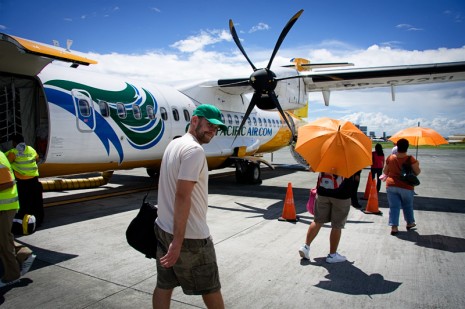
Ferries
In a country made up of 7,107 islands it’s almost impossible not to experience at least one trip on a ferry. Plying the routes between all major cities and most smaller cities and towns, ferries are a convenient and affordable way to experience the Philippines.
The boats range from large multi-deck ferries, that run the longer routes and usually have bunks or cabins for overnight journeys, to smaller and quicker catamaran type boats known as fast ferries, which usually have air-conditioning and a very loud movie playing.
Travel on board usually ranges in comfort level & cost, and boats are almost always full to overflowing, especially during peak holiday season.
This is not a full list of ferries in the Philippines, but covers some of the major operators. For more information, such as destinations and schedules you can check their websites.
- Super Cat
- Weesam Express
- Delta Fast Ferries
- Montenegro Shipping Lines
- Ocean Jet
- WG & A
- Negros Navigation
- Cebu Ferry Corporation
- Cokaliong Shipping
- Sulpico Lines (* disclaimer – this ferry sunk one of it’s vessels this spring resulting in many fatalities)
Also check out http://schedule.ph/ a handy site which lets you search schedules to 40 different locations with around 25 ferry operators. They claim to be up-to-date and so far seem pretty accurate, but schedules in the Philippines are always changing so best to ask locally or check the newspaper as most have schedules of the local operators listed.
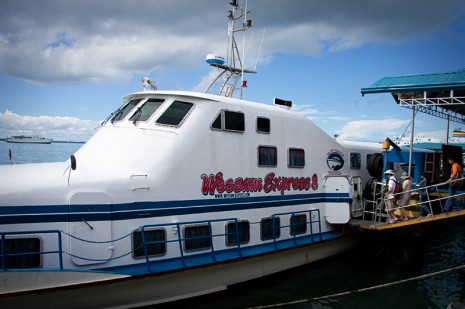
Bancas & Pumpboats
Bancas (also known as pumpboats) are the traditional form of water transport in the Philippines and you will see them everywhere. These traditional wooden boats have two wooden or bamboo outriggers and are usually powered by recycled car engines, so they can be quite noisy. They range in size, from larger multi-passenger boats to small single man fishing bancas. In addition to single trips between islands, bancas are used by many dive shops and tour companies for sight seeing and island hoping.
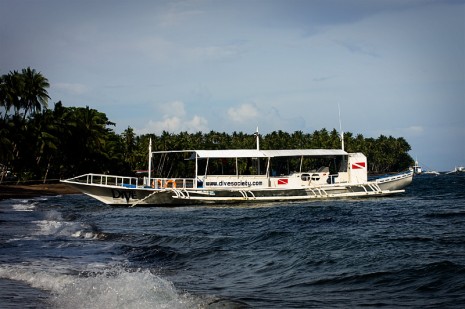
Buses
Dozens of bus companies service the Philippines, and are a good option for long haul trips. Fares are regulated by the government, so prices are cheap and service covers pretty much the entire country. You can travel all the way from the northern tip of Luzon to the southern tip of Mindanao thanks to “roll-on roll-off” ferries, also known as the RO-RO Highway.
There is no single bus terminal in the Philippines. Each bus company leaves from it’s own terminal, which often times can be on opposite sides of the city. Be sure to arrive early, especially if there is only one bus a day, as buses often leave early when they are full.
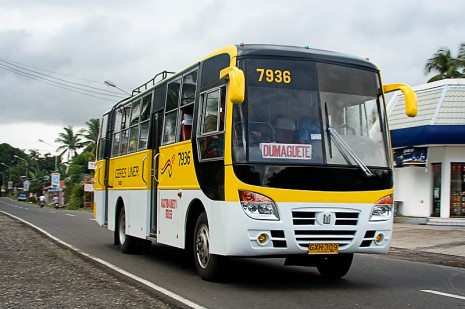
V-hire
Rivals to the regular bus, V-hires (vans or minibuses) are popular in many parts of the Philippines. They usually hang around bus depots, ferry terminals and busy tourist spots waiting to take passengers to set destinations. V-hires cost around two or three times that of a jeepney but are air-conditioned and much more comfortable. Unlike buses, V-hires don’t have a set departure time. They can carry up to nine passengers and usually wait till they are full before setting off.
Many vans can also be hired at a flat rate for the day, and are a great way to check out the local sights in air-conditioned comfort. In more touristy cities, drivers will often have set tours with established prices, but as always feel free to haggle.
Jeepneys
The undisputed “King of the Road” here in the Philippines is the Jeepney. Adapted from American jeeps that were left over after the second world war, a jeepney is basically a cross between a jeep and a bus. Brightly painted and decorated with chrome, lights, mirrors, and multiple hood ornaments, each jeepney is unique. They kind of remind me of the Electric Mayhem Bus from The Muppet Movie.
Jeepneys are mostly used for shorter trips around town or between neighboring cities. Fares are cheap, ranging from a couple of pesos in town, to 10-20 for longer trips. Each jeepney has a set route that it circles throughout the day, this is usually written on the front window or side of the jeepney. Jeepneys can be flagged down anywhere, just by standing on the side of the road and waving.
Seating consists of two benches that run the length of the jeepney and when those are full, makeshift stools are placed in the aisle for more seating. When those are full passengers hang off the back and even some times on the roof. When you want to get off simply clink your change on the roof and the driver will pull over to let you out. Though sometimes cramped for the taller western traveler, a jeepney ride is a truely unique filipino experience.
Multi-cabs
Similar to the jeepney, a multi-cab (or easy-ride) is a small truck that has been customized to carry passengers in the back along bench seats. Multi-cabs are smaller than jeepneys and not as garishly decorated, however function pretty much the same. Like jeepneys they run along set routes and you simply flag one down and climb aboard. They usually run similar routes to jeepneys as well but are also found in cities on less busy roads where jeepneys don’t go.
Tricycles
A tricycle or trike, similar to the thai tuk tuk, is basically a Philippine rickshaw. Made up of a small motorbike (125cc) and a metal sidecar bolted together, a trike is very useful for getting around town. Commonly used by locals to carry everything, including the kitchen sink, a trike can comfortably seat 2, maybe 3 western sized people, (although I have seen as many as 9 filipinos at one time).
Like most other taxis when you see one that’s empty simply flag it down and let the driver know where you want to go. Always negotiate the price before getting in and feel free to haggle.
Habal-Habal
A popular form of transportation in the mountain regions where trikes are rare and the roads are bad, a Habal-Habal is basically a motorcycle taxi. Usually customized with extra shocks and an extended seat, habal-habals commonly carry 4 to 5 people at a time.
Posted by: Shim
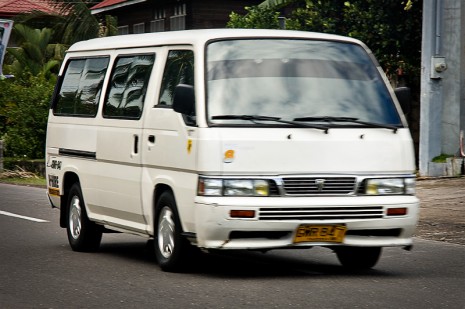
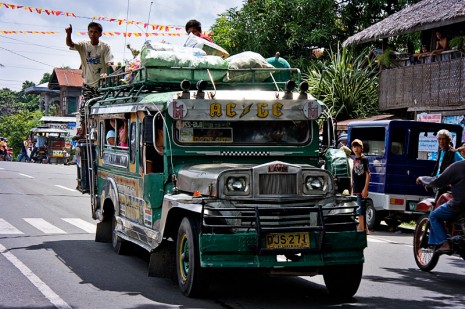
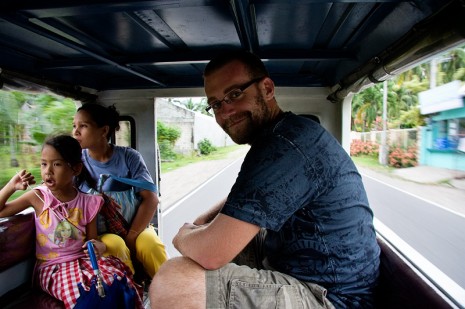
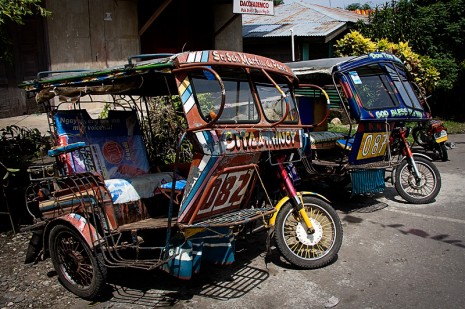
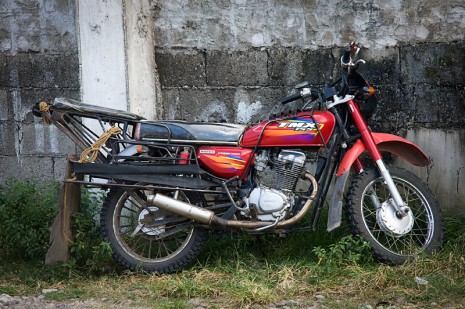








The V-hire can also be called ‘fx’. I saw them a lot in the city when I was in college.
Side note, a little envious here that you guys are in a nice clear and warm day. It’s kinda windy, cloudy and cold here in the East Coast. Sigh!
Enjoy the holidays.
Very helpful site. Thanks so much for having this. No travel agency in the US has this information so readily available.
Thanks Gary. We’re glad it’s helping you out. We hope you enjoy your trip to the Philippines!